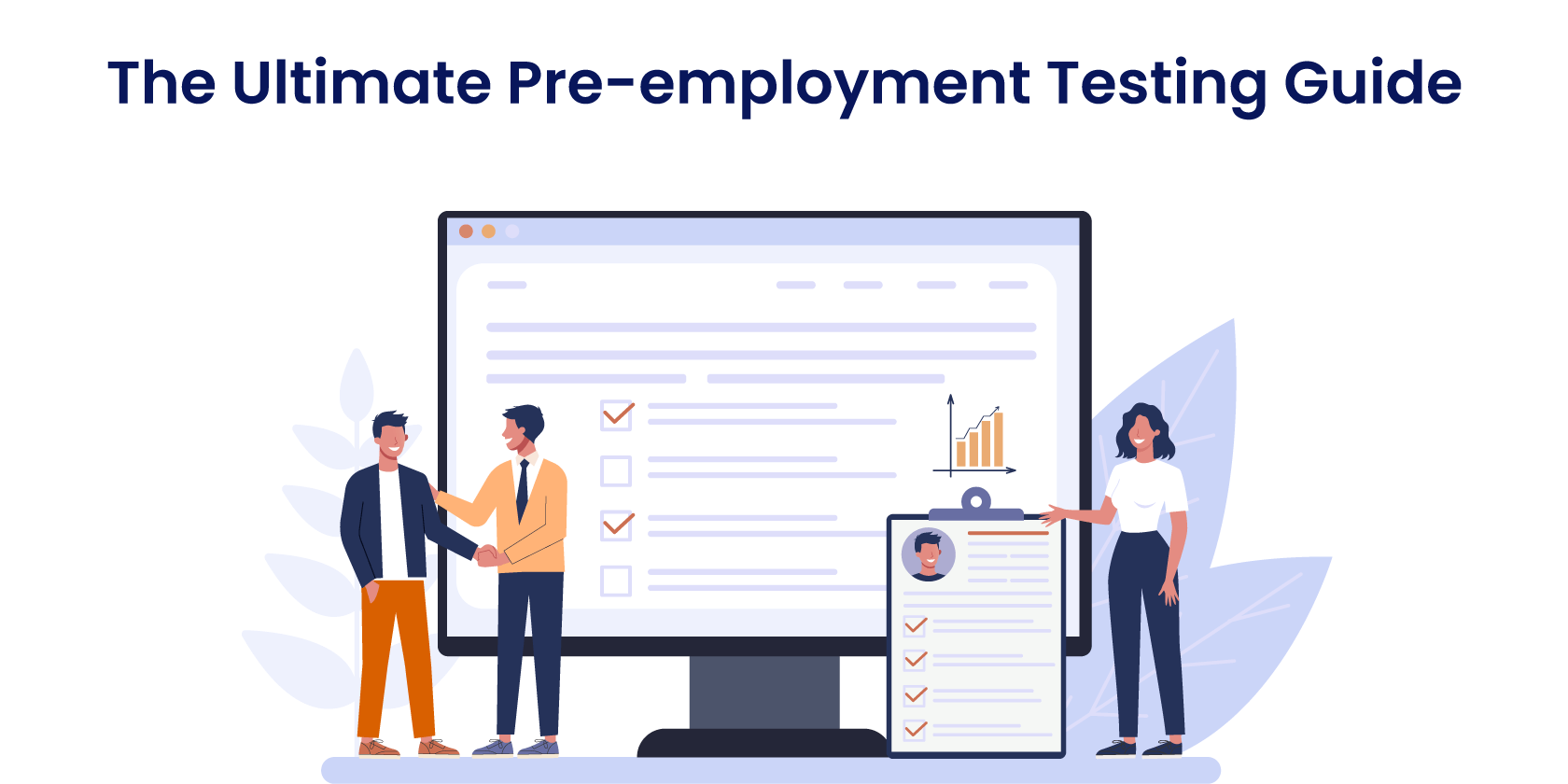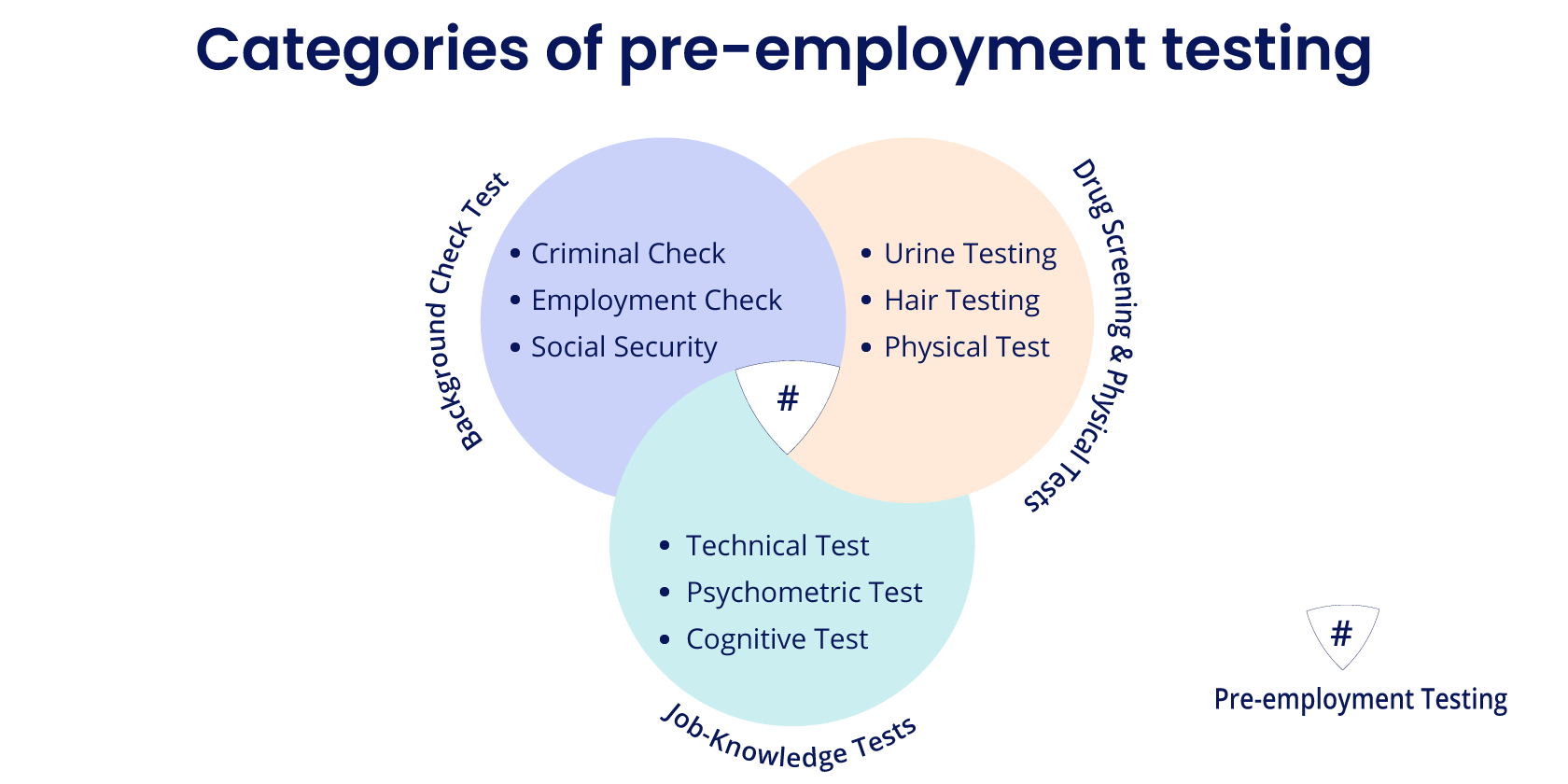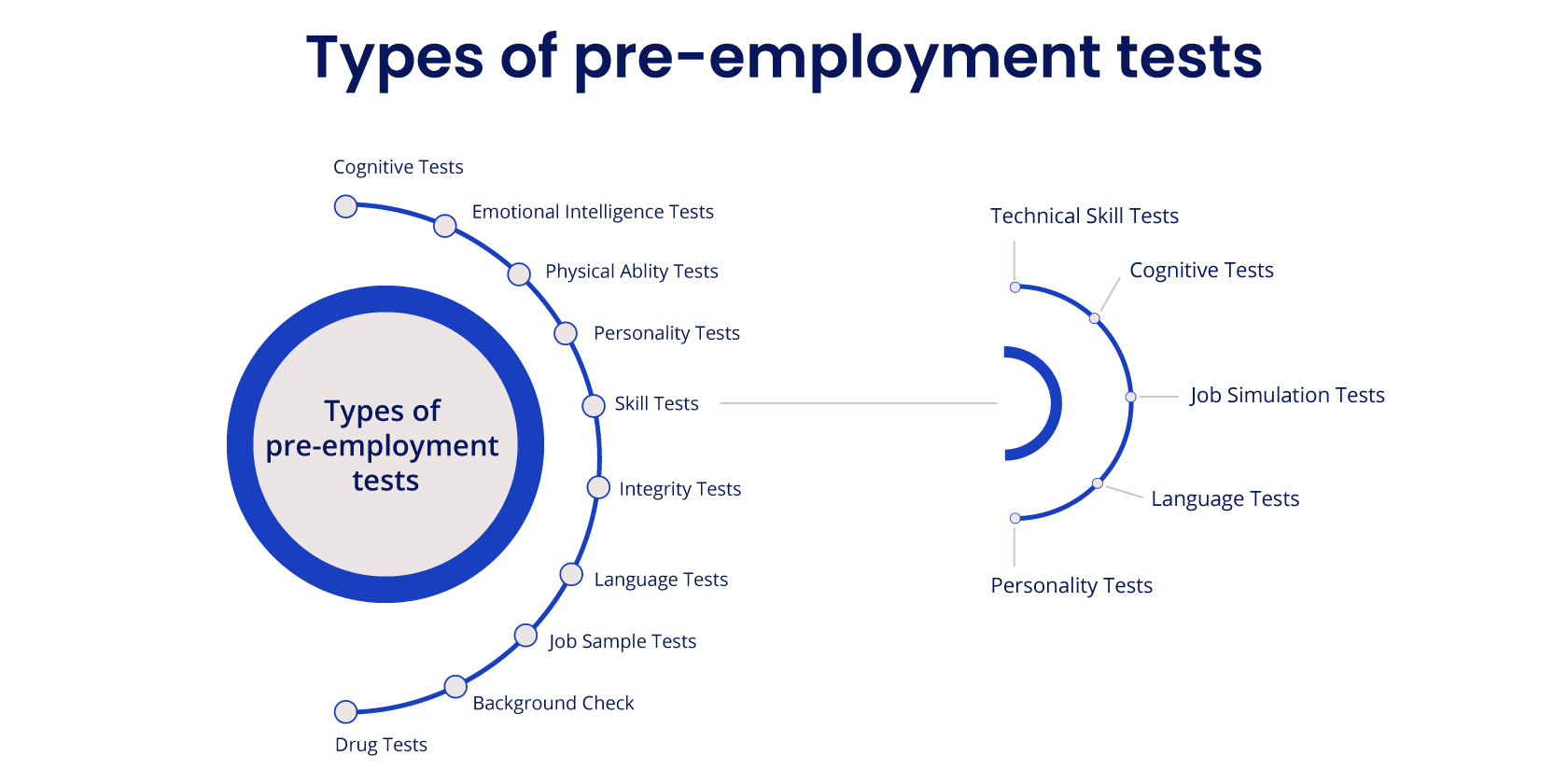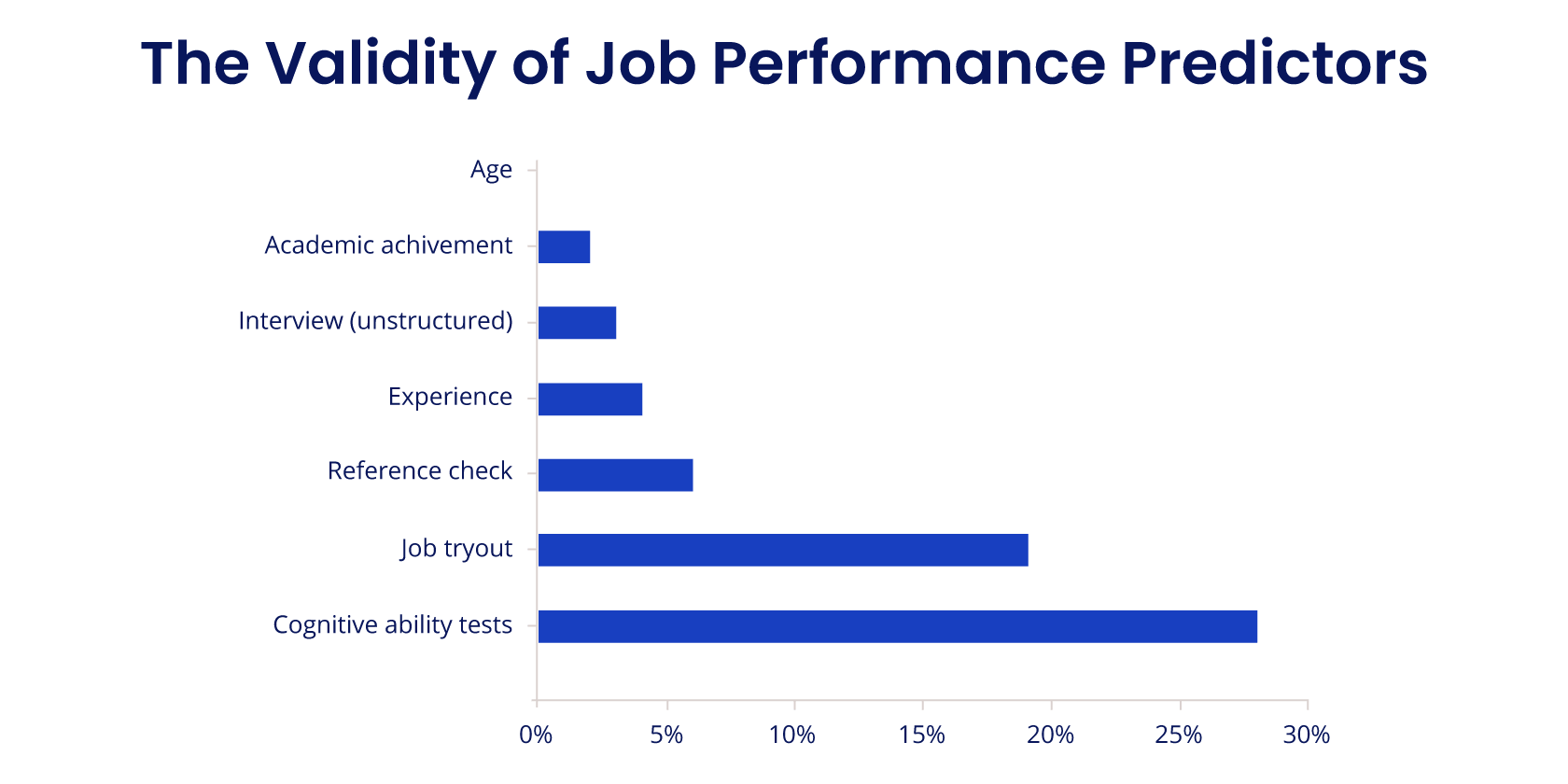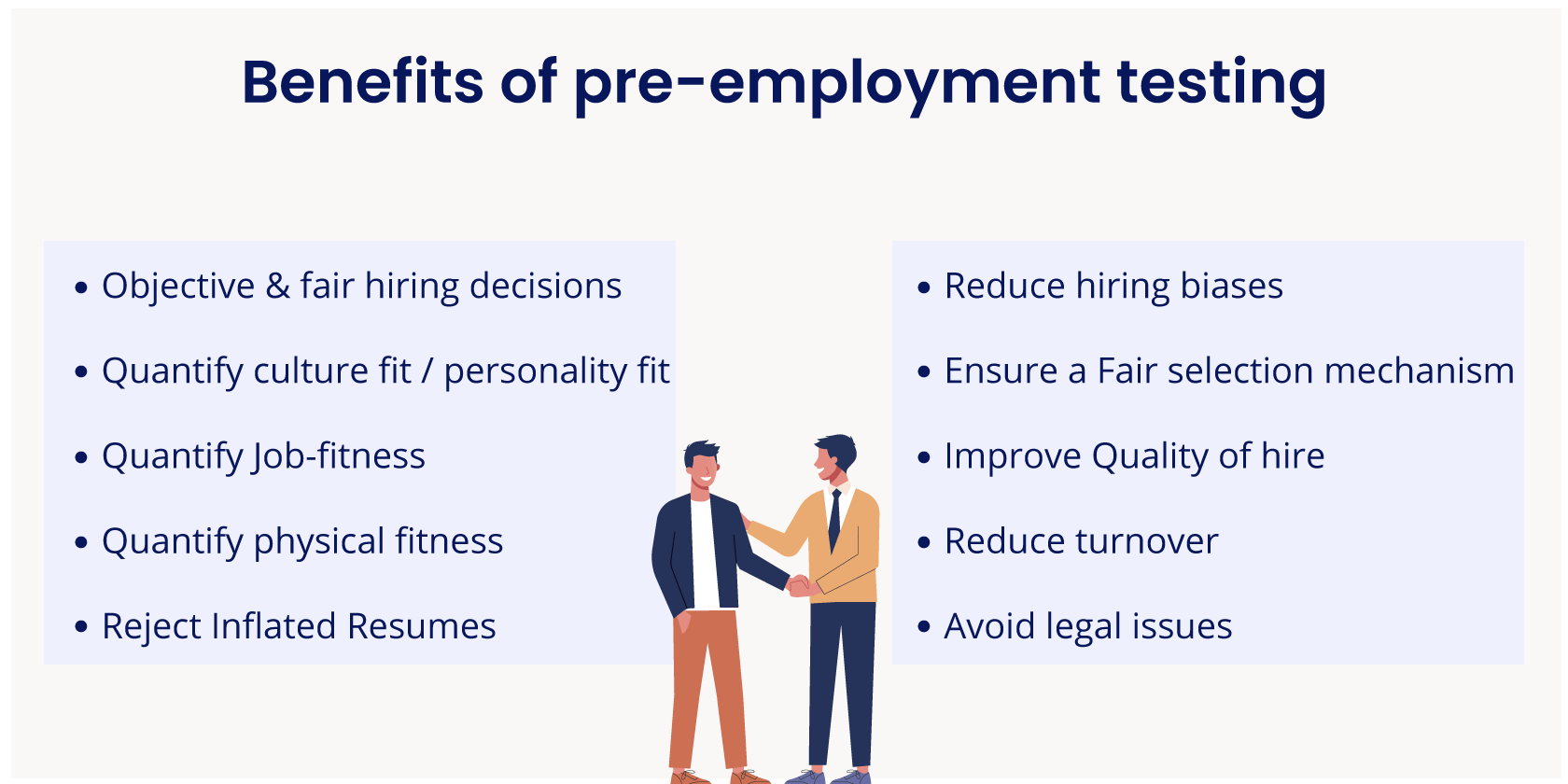Before that, let’s discuss why pre-employment testing is essential for hiring.
Why pre-employment testing is essential for hiring.
On average, companies in the United States spend approx. $4,000 to hire a new employee, and it takes them up to 52 days to fill a position (source: Glassdoor). By using pre-employment testing, the same companies can:
- Remove irrelevant candidates from the process as quickly as possible
- Get hiring managers to spend time with suitable candidates
- Remove bias from hiring decisions and processes
- And find the candidates that are most likely to succeed
These online pre-employment tests are faster, sustainable, and more objective, and also help organizations-
- Deliver a stellar hiring experience to the candidates
- Bring hiring managers & recruiters on the same page
- Help in hiring a diverse workforce without biases
- Ensure a legally compliant & fair hiring process
- Attract quality candidates & help in employer branding
- Improve employer branding
- Provide insights to improve talent acquisition strategies
“Almost 90 percent of firms that test job applicants say they will not hire job seekers when pre-employment testing finds them to be deficient in basic skills”
(Greenberg, 1996, p. 24).”
Types of pre-employment testing
There are various types of pre-employment tests, wherein each one is associated with
a very specific need.
Some tests are designed to test a person’s physical abilities, while others can
be used to measure an individual’s mental prowess. For some tests, the intent is to
identify if the person is harmless, whereas for some tests the intent is to determine
if the person is capable of conforming to a set of behavioral expectations.
But in the end, all these tests can be typically clubbed into 3 major categories:
Background Check: Background checks are indirect tests conducted by companies to verify the candidates’ background. These tests are conducted by a third party to check the candidate's record. Companies typically look for criminal records and employability history through these checks.
Drug Screening & Physical Tests: These tests determine the presence or absence of specified drugs in candidates. They help identify evidence of recent use of alcohol, prescription drugs, and illicit drugs. Urine and saliva testing are common methods of conducting these tests. Physical Ability tests measure the physical fitness of a candidate to do certain types of jobs.
Job-Knowledge Tests: Assesses levels of skill-based technical competency, cognitive abilities, and mental attitudes toward performance. Technical skills, Cognitive skills, and job-sample tests are the best examples of Job-knowledge tests.
Pre-employment testing can be further classified into various other types, such as:
- Skill Tests
- Cognitive Tests
- Personality Tests
- Integrity Tests
- Emotional intelligence tests
- Background Checks
- Drug Tests
- Language Tests
- Physical Ability tests
- Job Sample Tests
Each of the test types can then be further classified into various categories depending
on the need and nature of the job requirement. Examples: Technical Skills Test, Cognitive
Skills Test, Job-simulation Test, Language & Communication Test, Personality Test, etc.
Let's look at these types of pre-employment tests in more detail.
1. Skill Tests:
Resume fraud costs employers approximately $600 Billion annually and 57% of candidates
lie about their skill set. (Source)
Skill testing is the objective process of assessing the job-related skills of the
candidate, as it measures a candidate’s ability to apply skills while working on a
particular job.
These skills can be measured by presenting a series of scenarios to the candidates and evaluating their responses to those scenarios. Employers can also use job-specific skill tests to assess skills that are most relevant to the given job role.
1.1 Job-specific skill test:
Job-specific skill tests are specific to a particular job role or description.
A job-specific skill test can have any of the following types of topics or sub-tests
included in a single test.
- Technical
- Cognitive
- Job-simulation
- Language & Communication
- Personality
- Business Domain Knowledge
To create such test expertise knowledge, the science of assessments and the quality of
questions is given due importance. Job-specific skill tests can be created in 2 different
ways. You won’t find every pre-employment testing vendor providing this bifurcation, so
you will have to check.
2. Cognitive Ability Tests:
Wikipedia defines cognitive ability as “the ability of an individual to
perform the various mental activities most closely associated with learning and
problem-solving.”
The cognitive ability test assesses the candidates’ thinking process, problem-solving
abilities, and verbal ability.
A study by Hunter & Hunter shows cognitive tests are more effective in predicting job
performance than other job performance predictors like interviews and work experience.
The below-given graph indicates job performance predictors and their percentage of variance accounted for in job performance.
3. Personality Tests:
Personality assessments help companies evaluate whether a candidate is a cultural fit, and if the personality of a candidate is suitable for job success.
In today’s changing business scenarios and digital disruption, companies look for employees who not only possess the knowledge and intelligence but can also apply specific traits to perform a challenging job. In such situations, assessing the personality traits of the candidates has become important for companies.
According to a survey conducted by the Center for Executive Succession at the University of South Carolina’s Darla Moore School of Business, the major reason for the failure of executives at work performance is behavioral compatibility or personality types like ego, selfishness, etc., and their failure to fit with other team members.
Several tests are used for personality testing. Some of the most commonly used tests include Myers-Briggs, DISC, The Caliper profile, SHL occupational personality, and Hogan personality inventory.
Let us understand these in more detail -
3.1 Myers-Briggs Personality Type Indicator: This test helps in finding out
if an employee’s personality falls into one of two tendencies from various groups
like “Extraversion vs. Introversion”, “Intuition vs. sensing”, “Thinking vs.
Feelings”, and “Judging vs. Perceiving.” In the Myers-Briggs questionnaire, a
candidate is presented with two options A or B and the selected options help
companies find out which tendencies the candidates lean toward.
3.2 DISC Personality Assessment: This test assesses the observable behavior of a candidate rather than skills. It focuses on how a candidate behaves rather than how he/she thinks about something. DISC personality assessment divides behaviors into four quadrants: dominance (D), influence (I), Steadiness (S), and Consciousness (C).
3.3 The Caliper Profile: This test measures how an individual's personality traits correlate to his/her job performance. The questionnaire in this assessment includes a few statements and the candidate has to select the statement that best suits his/her viewpoint.
3.4 SHL Occupational Personality Questionnaire: SHL occupational personality questionnaire measures 32 personality characteristics relevant to performance. Candidates are given a few statements and the candidate has to choose which statement best describes him/her. Candidates are evaluated in three main domains ‘emotions’, ‘relationship with people, and ‘thinking style and feeling’.
3.5 Hogan Personality Inventory: HPI is based on the five-factor model and evaluates seven primary scales and six occupational scales, which are- service orientation, stress tolerance, reliability, clerical potential, sales potential, and managerial potential.
3.6 Big Five Personality Theory: A group of independent scientists has defined five broad traits of a human personality based on research. These big five personalities are ‘Openness’, ‘Consciousness’, ‘Extraversion’, ‘Agreeableness’, and ‘Neuroticism’.
How reliable are these personality tests, you may ask?
Correlations between personality and job success fall in the .03 to .15
range- 2007 review of academic literature published in Personnel Psychology
Don't rely solely on personality tests to predict how candidates will respond
to certain situations in the job. It is better to use personality tests
alongside other assessment tools to make a more informed decision.
4. Integrity tests:
Integrity tests fall under the sub-category of personality tests and are useful to assess candidates’ ethical views.
The questions are framed in such a manner that they help in identifying if a candidate will lie, follow unethical practices, rob the company for monetary gains, face disciplinary problems, or even get into violent activities.
However, the challenge with integrity tests is that it is easy to fake the answers. It is hard to evaluate if the candidate has made up things or is telling the truth.
5. Emotional intelligence tests:
Emotional Intelligence, in simple terms, is a person’s ability to understand and control their own emotions and the emotions of other people. It has become a hot topic of discussion these days and is regarded as a key component of success in the workplace.
Various studies from Harvard and Stanford have found that 85–87% of a person’s success is attributed to soft skills, emotional intelligence, and interpersonal skills.
Yet, traditionally, only a fraction of companies have been paying attention to this vital
aspect.
However, emotional intelligence has now become one of the most sought-after skills by
companies after job-specific skills.
Emotional intelligence tests help companies evaluate candidates’ behavior on various
aspects such as - response to stressful situations, working with a diversified team,
handling challenges, self-awareness, managing emotions, and empathy.
Just like integrity tests, emotional intelligence tests can also be faked. That apart,
company culture can change a candidate’s personality if the candidate has a knack for
keeping things right and has the right attitude.
6. Background Check Tests:
Nearly 72% of employers run a background check for every person they hire.
Background checks consist of investigating a candidate’s background to verify that a candidate is who he/she claims to be. Background checks may include employment check, education history checks, criminal record checks, credit history, and more. Special care should be taken while performing background tests as you need to inform the candidate which tests you are conducting. In case of rejection based on the background checks, you need to show the candidate the certificate of the background checks.
6.1 Employment Background Check:
85% of employers report finding misrepresentations on a resume or job application.
An employment background check may include checking past work history, medical
history, social media, criminal record, driving record, credit card history, & drug
screening. An employer may outsource this task to a third party to get accurate
information.
6.2 Criminal Background Check:
The criminal background check involves checking state & national-level criminal
records of candidates. The records include if a candidate is involved in any type of
arrest, conviction, sexual offenses, warrants, etc.
6.3 Credit Background Check:
A credit background check is performed by employers for job roles that directly
deal with managing money. This includes checking the credit-to-debt ratio to see how
employees have managed past credit and bill payments. Employers may also check
bankruptcy information.
6.4 Driving Record Background Check:
Employers may check the driving records of the candidate to confirm any record
of breaking traffic violations and major accidents.
6.5 Social Security:
Social Security Number Trace is performed to trace the candidate’s residential history. This information helps to create a list of jurisdictions that should be checked for the criminal record check.
7. Drug Testing:
As a part of the background check, verification companies also ask candidates to take a drug test. Candidates are not notified in advance about the drug test so that the tests can provide more accurate results. Candidates are directed to a laboratory to submit a sample for drug screening.
At the laboratory, the applicant has to submit a sample of any of the following - hair, sweat, urine, saliva, or blood drug test.
As there can be legal concerns in the future, strict procedures are followed to document and prevent the adulteration of the sample.
Drug testing is used to check if the candidate has recently used illegal drugs. This is performed to avoid hiring a drug-addicted candidate and protect employees from possible drug or alcohol abuse.
The latest update in drug testing was the removal of the ban on Marijuana drug testing. Nevada becomes the first state in the US to ban pre-employment Marijuana drug testing. Newsweek.com
8. Language Test:
Communication is a critical part of any team, and it’s essential for team collaboration. Clear and effective communication among team members is helpful for the achievement of team goals.
Language proficiency tests include the evaluation of candidates’ communication skills in a particular language. This may include basic vocabulary checks related to the role and checking the candidates’ written communication skills.
9. Physical Ability Tests (PAT):
Physical ability tests measure the candidates’ ability to perform certain job-related tasks. These tasks measure physical abilities, such as strength, endurance, and stamina.
Examples of a few physical ability tests include-
-
Balance Test: Tasks in which stability of body position is difficult to maintain
-
Flexibility Test: Tasks including bending or stretching in involved
-
Cardiovascular Endurance Test: Task assessing aerobic capacity
-
Muscular Tension Test: Tasks that involve pushing, lifting, and pulling
But, why you should perform PAT?
If the job involves physical activities, then it is advisable to conduct a physical
ability test (PAT) before you select a candidate. Conducting PAT can give you the
benefit of reducing the time and cost caused by possible accidents. The other
benefits include-
- Improved productivity
- Lower worker replacement cost
- Improved job performance & employee satisfaction
- Reduction in medical costs
EEOC guidelines mandate that whenever you use PAT, it should be validated and the
candidates should be tested only for tasks that are needed for accomplishing the
job. Employers may face severe punishment if EEOC finds out that tests are
discriminatory.
10. Work Sample Test:
Work sample testing requires the candidate to go through a similar type of task as that of an actual job. These types of tests are considered to have high content validity.
There are different types of work sample tests, such as:
i. Work sample test (with training): Here, the candidates are expected to learn the tasks through
instructions and then perform those. This type of testing is suitable for candidates with minimum
or no experience.
ii. Low-Fidelity Simulation:
Here, the candidates are given a description of work situations and
five options. They need to select responses that they are most likely and least likely to make.
iii. Work Simulation Tests:
The candidate is given real-time work-life situation and asked a
series of questions so that they can describe decisions they would make in each
situation.
Benefits of Pre-employment Testing
Now let’s have a quick look at how carefully crafted, calibrated & well-maintained online testing tools can help various stakeholders in an organization.
Common benefits of pre-employment testing
Online testing tools, enable technology to play a vital role in increasing the number of applicants
and helps employers incorporate these pre-employment tests into the recruitment process through a simple
integration.
What's more, companies of all sizes can use pre-employment testing tools to get better control over the vast talent pool that is applying for open job opportunities and select job-fit candidates faster.
14 Tangible Benefits of Pre-employment Testing for Employers:
-
Reduced administration:
Online tests don’t demand any specific administration and candidates can give them any time and from anywhere.
-
Automatic process:
Results are just a click away, saving a lot of time in manual test evaluations. Additionally, immediate post-test feedback helps in keeping the candidates motivated and engaged.
-
Data and complete test analysis:
Get actionable and valuable analysis/insights of tests at a micro, as well as macro level.
-
Instant diagnostic reports:
Detailed reports enable all the stakeholders to analyze results in real-time.
-
Ensure Quality candidates:
Easily weed out poor-fit applicants and increase the chances of hiring only high-quality candidates.
-
Eliminates human error in grading:
Automated scoring ensures that the skill evaluation process is free of human error; is more valid and reliable.
-
Minimize the risk of bad hires:
Accurately judge the candidates’ skills using scientifically designed questions, and minimize the chances of bad hires.
- Improve hiring decisions:Make better hiring decisions by easily identifying job-fit candidates. Get valuable insights into the candidates’ job readiness and future job performance.
-
Reduce time-to-hire:
Avoid the unnecessary, low-value, and cost-increasing elements in the hiring process.
-
Increased productivity:
Increase the recruitment and hiring team’s productivity by reducing unnecessary tasks.
-
Reduced Hiring Biases:
Avoid discrimination against candidates based on gender, age, race, and region. Make hiring decisions purely based on candidates’ proven competencies.
-
Data handling & Storage:
Avoid the hassle of manual management and storage of all candidate and test-related data.
-
Wider reach:
Allow qualified applicants from remote locations to apply for jobs and appear for the initial round of testing. Hence, improving the reach of the organization’s hiring drive.
-
Better candidate engagement:
Actively engage candidates early in the hiring process, and ensure higher candidate satisfaction through a seamless hiring process.
Benefits of Pre-employment Testing for Hiring Managers
- Saves interviewer’s time by avoiding interviews with irrelevant candidates
- Get high-quality candidates from recruiters
- Hire job-fit candidates
- Avoid bad hires, time spent on PIP, lack of results, and project failures
- Deliver projects on time by filling up the requirements quickly
- Access ready-to-use next-gen skills tests that are useful for hiring new-age talent
- Access a large pool of questions and prevent questions from getting leaked
- Save billable hours by interviewing only the relevant candidates
Benefits of Pre-employment Testing for Recruiters
- Recruit job-fit candidates
- Quickly filter out irrelevant candidates early in the process
- Easily track & measure each recruiter’s performance
- Improve Time-to-Hire
- Keep track & measure sourcing mechanisms
- Remove hiring biases
- Reduce recruitment costs
- Deliver better candidate experience
Benefits of Pre-employment Testing for VP Talent Acquisition
- Leverage the power of data and analytics in the hiring process
- Enhance employer branding
- Warrant diversity in hiring by removing hiring biases
- Ensure legal compliance and a fair-to-all hiring process
Benefits of Pre-employment Testing for Recruiters
- Easy identification of inflated resumes
- Quick screening of job applicants
- Validate technical skills of candidates
- Accurate validation of candidates’ technical skills without going through the hassles of scheduling interviews
- Be on the same page as the Hiring Manager
Benefits of Pre-employment Testing for Candidates
- Get a fair hiring process
- Get a good interview experience
- Avoid traveling to the employer's office multiple times during the interview process
- Get access to a platform where you can showcase your knowledge and skills
Gett reduces time to hire and brings in transparency
The challenge that I faced while hiring for Business Analyst or any other position in my team is reaching out to the right candidate. A typical job opening at Gett attracts almost 80-90 resumes. While, on paper, maybe 50 of them fit the bill, there is no sure way of knowing the
right fit unless each one is interviewed individually. Another challenge was eliminating human bias while hiring. Since, our process was so dependent on resumes, telephonic, and personal interviews; there was a possibility however marginal that human biases could creep in. In the larger scheme of things, this played out as a significant factor.
As an analytics team head, I have a firm belief in data and data-driven decision making. With iMocha, we got the clarity we were looking for. I created a BA assessment emphasizing analytical and logical thinking skills. These assessments were used for 1st level screening.
As an analytics team head, I have a firm belief in data and data-driven decision making. With iMocha, we got the clarity we were looking for. I created a BA assessment emphasizing analytical and logical thinking skills. These assessments were used for 1st level screening.
This eliminated over-reliance on resumes removed irrelevant candidates, and brought transparency to the process. Another major advantage is that there is absolutely no need for the candidates to travel down to our office, they can appear for the assessment from anywhere and iMocha's powerful anti-cheating measures ensure that it's a fair attempt.
We finally got the right candidate, that too in ¼ the time it would have normally taken us.
-George Nichkov (Global Analytics Team Lead, Gett).
Read More...
Next Topics in this guide
In this guide, we also cover topics such as:
Laws Governing Pre-Employment Tests:
Know about the legal issues involved with pre-employment testing that may comply with EEOC guidelines or adequate security measures that must be taken before giving a test to any candidate.
How to choose your pre-employment testing vendors?
Know how to strategize and include the pre-employment tests into your recruiting process.
You will be able to choose and check the effectiveness of the pre-employment tests.
Pre-employment tests 101 for Candidates:
Recruiters and HR aren't the only ones who are interested to know about pre-employment
testing. Candidates are well aware of the importance of pre-employment testing and
there are a lot of basic questions that must be answered. Head over to the candidate's
section to know more.



